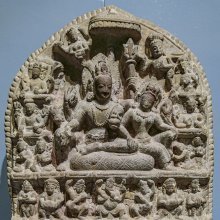Alinganamurti, Āliṅganamūrti, Alingana-murti: 2 definitions
Introduction:
Alinganamurti means something in Hinduism, Sanskrit. If you want to know the exact meaning, history, etymology or English translation of this term then check out the descriptions on this page. Add your comment or reference to a book if you want to contribute to this summary article.
Images (photo gallery)
In Hinduism
Shilpashastra (iconography)
Source: Wisdom Library: Śilpa-śāstraĀliṅganamūrti (आलिङ्गनमूर्ति) refers to a class of candraśekharamūti, which is an image (mūrti) which has candra (moon) as its head-ornament.The term is used throughout Śilpaśāstra literature.
Source: Google Books: Elements of Hindu iconographyĀliṅganamūrti (आलिङ्गनमूर्ति).—The third variety of Candraśekharamūrti;—In this aspect, the Candraśekhara is to be represented as embracing the Devī With one of his left arms:
1) This arm might rest upon the left side of the Devī just below her breast, or it may be placed upon the left arm of the Devī, outside the pārśva-sūtra; the Devī should keep in her right hand a red lotus flower.
2) Or, the right hand of the Devī may embrace Śiva, in which case the hand of the Devī should rest on the right side of Śiva a little above the waist zone; and the left hand of the Devī should carry a flower.
3) Or, the two figures of Śiva and Umā may be embracing each other, the one with the left and the other with the right hand.
Thus there are three modes in which the figure of Āliṅgana-candraśekhara may be sculptured.

Shilpashastra (शिल्पशास्त्र, śilpaśāstra) represents the ancient Indian science (shastra) of creative arts (shilpa) such as sculpture, iconography and painting. Closely related to Vastushastra (architecture), they often share the same literature.
See also (Relevant definitions)
Partial matches: Alingana, Murti.
Full-text: Brahma, Candrashekharamuti, Krittivasa.
Relevant text
Search found 3 books and stories containing Alinganamurti, Āliṅganamūrti, Alingana-murti, Āliṅgana-mūrti; (plurals include: Alinganamurtis, Āliṅganamūrtis, murtis, mūrtis). You can also click to the full overview containing English textual excerpts. Below are direct links for the most relevant articles:
Later Chola Temples (by S. R. Balasubrahmanyam)
Temples in Chintamani Agaram < [Chapter II - Temples of Kulottunga I’s Time]
The Religion and Philosophy of Tevaram (Thevaram) (by M. A. Dorai Rangaswamy)
Chapter 1.3 - Umabhaga-murti (depiction of the Mother Goddess) < [Volume 2 - Nampi Arurar and Mythology]
Early Chola Temples (by S. R. Balasubrahmanyam)
Temples in Kodumbalur < [Chapter IV - Temples of Sundara Chola’s Time]
Related products

